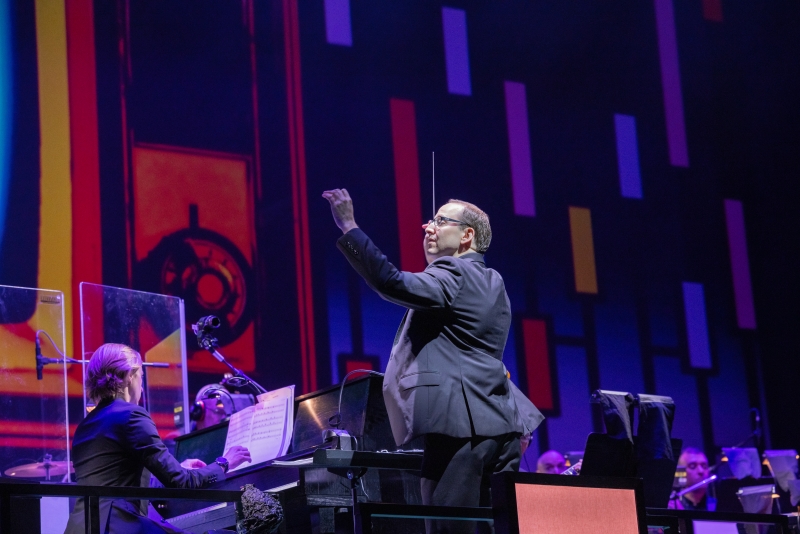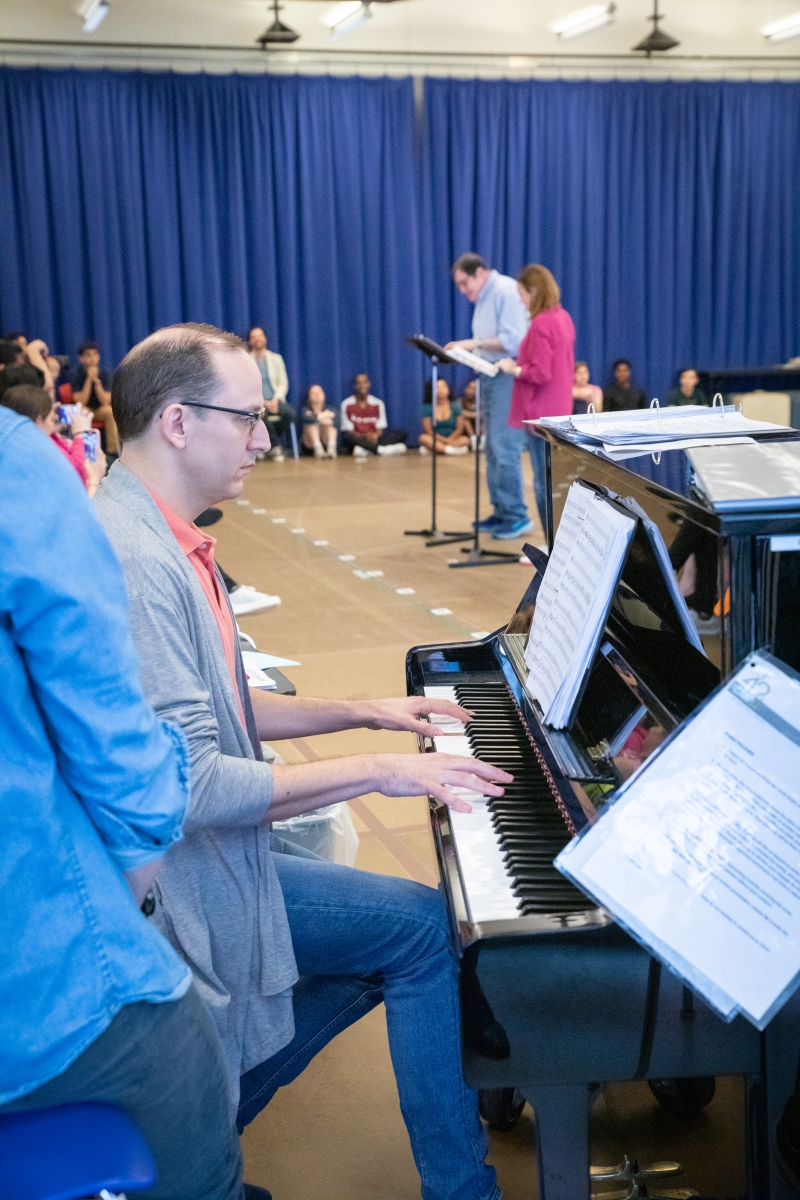Interview: Kennedy Center's Musical Director on Why BYE, BYE, BIRDIE's Orchestrations Sound Better Than Ever
Musical Director John Bell on partially restoring Robert "Red' Ginzler's original orchestraions for Kennedy Center's current production and more.

Photo by Matthew Murphy and Evan Zimmerman.
Nowadays orchestra size has become more and more of an issue for me. Even when seeing productions of classic Broadway musicals, there is a tendency to reduce the size of the orchestra for more in the way of production elements. It’s even worse when a production “reimagines” the charts completely and wipes away the work of Robert Russell Bennett, Don Walker, and even Jonathan Tunick. The latter should be deemed sacrilege.
Kennedy Center’s Broadway Center Stage series is currently presenting Bye, Bye, Birdie through June 15th. The 1960 Charles Strouse/Lee Adams musical originally had a 31-piece orchestration by Robert “Red” Ginzler. A legend of his time. After all, he co-orchestrated Gypsy with Sid Ramin. Over time, as Bye, Bye Birdie, went into stock and amateur licensing, Ginzler’s original charts were sadly reduced to make them easier to play for less seasoned musicians. This meant changing reed voicings etc.
John Bell is the musical director for Kennedy Center’s production of Bye, Bye, Birdie but that is not his only job on the production. John thankfully has done a partial restoration of Ginzler’s original orchestrations in order to clean up some of the injustices that have been done to them over the years. The result is a 22-piece sterling sounding set of charts that I’m sure would make Mr. Ginzler (and Dance Arranger John Morris) smile. I have to assume for sheer space on the stage of the Eisenhower, the other nine string chairs had to be jettisoned. There are still eight of them, which is more than I can say for some modern musicals. Bravo! Maestro Bell for caring about the music in a MUSICAL!!
Read on for how the process of restoring a classic Broadway musical happens and how many years of John’s association with Encores! helped in the task of restoring Bye, Bye, Birdie.
Let’s face it, most theatregoers probably don’t even care about how the music sounds when they go to a show. I can’t tell you how many times I’ve attended productions where I’ll hear an audience member say “Wow, that recording sounded like an actual orchestra.” Well yes, you idiot!! There was an actual orchestra!
Programs like Encores! and Broadway Center Stage exist to feature the orchestra besides showcasing the material. The point is to show audiences that ACTUAL musicians make the music in a MUSICAL!
Bye, Bye, Birdie is one of those Golden Age of Broadway shows that isn’t presented professionally very often. Here is your chance to hear the show as originally intended. John Bell along with Joshua Clayton (additional orchestrations) have lovingly brought back the work of an almost forgotten orchestrator. Robert “Red” Ginzler and many others should never be forgotten. Just remember, without the orchestrator, it’s a just a piano.
Is Bye, Bye, Birdie the first time you yourself are doing an orchestration restoration in addition to musical directing?
Yes, this is the first time that I am supervising this kind of a project myself. However, I must say that Josh Clayton has been crucial to this undertaking, and none of this would have happened without him. Josh is the Director of Music Administration and Score Restoration for City Center’s Encores! Series. His knowledge of classic, Golden Age Broadway orchestrations is unmatched. This is an important part of American History, and his expertise is masterful. While I can identify where the work needs to be done, and why we should do it, Josh actually knows how to do that work, and how to get the music on the stands so that the orchestra can play it. I would also like to note that there is some new musical material for this production – new dance arrangements and transition music, and Josh has done those orchestrations. His understanding of this style of orchestral writing allows him to weave in and out of the score in such a way that you cannot tell where Ginzler leaves off and Clayton begins. This is essential for retaining the style of the piece.

Bye, Bye, Birdie perform "The Telephone Hour" with John Bell
and the Kennedy Center Orchestra.
Photo by Matthew Murphy and Evan Zimmerman.
Robert “Red” Ginzler’s original orchestrations for Bye, Bye, Birdie have not been heard for many years. How was the decision made to restore his original charts for the Broadway Center Stage version?
A project like this is never possible without the support of leadership. I am deeply grateful to Jeffrey Finn (Executive Producer of Theater at the Kennedy Center, and Artistic Director of the Broadway Center Stage Series) and Marc Bruni (director of Bye, Bye, Birdie). They wanted to showcase the incredible score of Bye, Bye, Birdie and the fantastic orchestra at the Kennedy Center, and valued the work necessary to make this possible. In my first meeting with Marc Bruni, he told me how much he loved these orchestrations, and how important he believed they were to the spirit of the show and of this production. So, I took that and ran with it.
Can you please take us through the process of restoring a set of orchestrations back to their original form?
I was able to ascertain scans of Robert Ginzler’s original, handwritten full scores for Bye, Bye, Birdie. What a treasure! I hibernated for a few days, and I compared those scores, bar by bar, with the orchestrations that are licensed. First, I got rid of any unnecessary cueing and doubling, because we have a full orchestra, and we would not be missing any instruments. Then I started to analyze where things had been significantly rewritten and redistributed. For example, the iconic woodwinds fills and counter melodies in “Put On a Happy Face” were originally on flutes and had been redistributed for a flute and clarinets. There was a gorgeous, plaintive alto flute solo at the top of “Baby, Talk to Me” that had been put on a clarinet. The string writing in the Overture needed some attention and redistributions, especially in the section where the strings (to gorgeous effect) play the melody of “Put on a Happy Face.” A fun piccolo part in “Rosie” had been put on the flute, which would simply not “chirp” in the same way. These are just some examples of where I felt it would be advantageous to restore the original orchestrations – where it would really affect the quality of the sound and make a noticeable difference in the way the audience experiences the score. We were lucky to have Ginzler’s original scores. Sometimes, even the original full scores have been lost, and then it becomes much more of an archaeology project.

of Bye, Bye, Birdie.
Photo by Shay Frey.
You have worked on many productions at Encores!. That company specializes in restoring or using the original orchestrations for all of the shows they produce. Has working at Encores! prepared you for the daunting task of restoring the orchestrations for Bye, Bye, Birdie?
I would not be able to do any of this work if it had not been for my years spent at Encores! – working with the great music directors Rob Berman and Rob Fisher. I have had the opportunity to work on orchestral restoration projects with both of them, and those are learning experiences that you simply cannot replicate. I am so grateful for their friendship and mentorship. I count these relationships as some of the greatest gifts of my career.
With many revivals nowadays choosing to reduce or totally reorchestrate the music, why do you feel it’s important that names like Robert “Red” Ginzler, Robert Russell Bennett, Philip J. Lang, Sid Ramin, Don Walker, and other Golden Age of Broadway orchestrators are always acknowledged and why should companies consider using their original charts over a reduction?
I believe that the American musical holds great cultural and historical importance. The sound of the Golden Age of Broadway was not created by composers alone (although the composers were amazing and crucial!). The orchestrators and arrangers of the time (that you mention) contributed greatly to the style and content of what we think of when we close our eyes and dream about the classic Broadway musical experience. These were incredible artists and interesting people who are a vital part of this great tradition. I would also like to add Trude Rittmann to this list, whose dance and vocal arrangements on many of the most popular musicals of the Golden Age (Brigadoon, Oklahoma, The King and I, My Fair Lady, to name a few) are iconic, and also a major contribution to the art form.
I think most decisions about which orchestrations to use are influenced by budget. Obviously, it is wonderful to have a full, lush orchestra, and that is something that I always advocate for whenever possible. But I understand that for many companies, this may not be realistic. Necessity can be the mother of invention, and there have been wonderful, creative, smaller orchestrations of musicals that are very exciting. And there may also be instances where a creative team is reworking a show, and so to use the original orchestrations would not be appropriate. But if you are looking to deliver a classic, Golden-age experience to your audience, the orchestra is essential.
What is the biggest lesson you have learned since starting the process of restoring the original orchestrations for Bye, Bye, Birdie?
This work is creative and musical, but it also has a crucial administrative component. Start as early as possible, be organized about the work that needs to be done and develop excellent time and resource management skills.
Special thanks to Kennedy Center's Director of Public Relations Brendan Padgett for his assistance in coordiating this interview.
Comments

Videos

